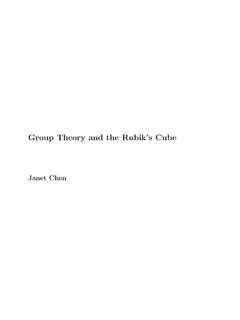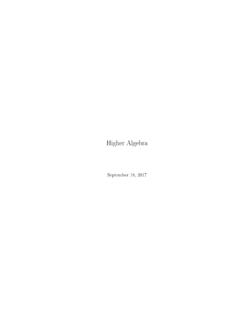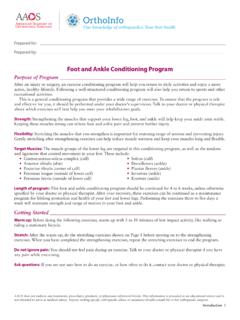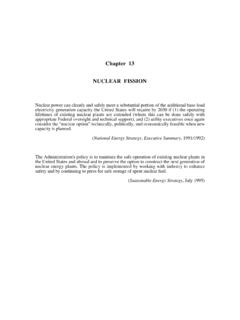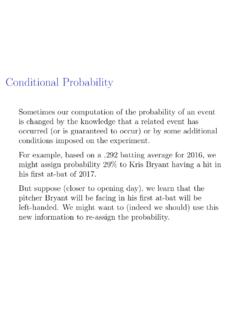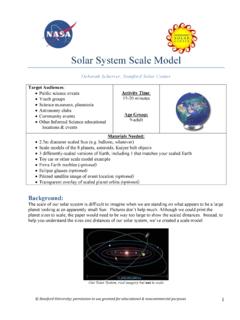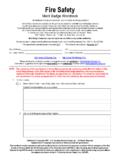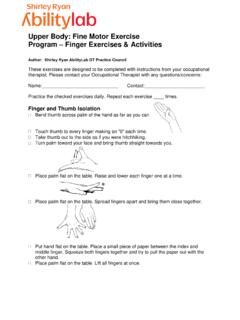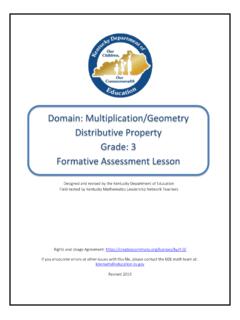Transcription of Sequences and Series: An Introduction to Mathematical Analysis
1 Sequences and Series: An Introduction toMathematical Analysisby Malcolm R. Adamsc The general concept of a sequence .. The sequence of natural numbers .. Sequences as functions .. Convergence .. Tools for Computing Limits .. What is Reality? .. Some Results from Calculus .. 682 Introduction to Series .. Series with Nonnegative Terms .. Series with Terms of Both Signs .. Power Series .. 983 Sequences and Series of Uniform Convergence .. Taylor Series .. Complex Numbers .. 126iChapter The general concept of a sequenceWe begin by discussing the concept of a sequence. Intuitively, a sequenceis an ordered list of objects or events. For instance, the sequence of eventsat a crime scene is important for understanding the nature of the crime.
2 Inthis course we will be interested in Sequences of a more Mathematical nature;mostly we will be interested in Sequences of numbers, but occasionally wewill find it interesting to consider Sequences of points in a plane or in space,or even Sequences of s look at some examples of flips a quarter five times, the sequence of coin tosses is HTTHT where H stands for heads and T stands for tails .As a side remark, we might notice that there are 25= 32 different possiblesequences of five coin tosses. Of these, 10 have two heads and three the probability that in a sequence of five coin tosses, two of them areheads and three are tails is 10/32, or 5/16. Many probabilistic questionsinvolve studying sets of Sequences such as picks colored marbles from a bag, first he picks a red marble, thena blue one, another blue one, a yellow one, a red one and finally a blue sequence of marbles he has chosen could be represented by the 1.
3 SEQUENCESE xample the Hare set out to walk to the neighborhood grocery. In the firstten minutes he walked half way to the grocery. In the next ten minuteshe walked half of the remaining distance, so now he was 3/4 of the way tothe grocery. In the following ten minutes he walked half of the remainingdistance again, so now he has managed to get 7/8 of the way to the sequence of events continues for some time, so that his progress followsthe pattern 1/2, 3/4, 7/8, 15/16, 31/32, and so on. After an hour he is 63/64of the way to the grocery. After two hours he is 4095/4096 of the way tothe grocery. If he was originally one mile from the grocery, he is now about13 inches away from the grocery. If he keeps on at this rate will he ever getthere? This brings up some pretty silly questions; For instance, if Harry is 1inch from the grocery has he reached it yet?
4 Of course if anybody manages toget within one inch of their goal we would usually say that they have reachedit. On the other hand, in a race, if Harry is 1 inch behind Terry the Tortoisehe has lost the race. In fact, at Harry s rate of decelleration, it seems that itwill take him forever to cross the finish s friend Terry the Tortoise is more consistent than Harry. He startsout at a slower pace than Harry and covers the first half of the mile in twentyminutes. But he covers the next quarter of a mile in 10 minutes and the nexteighth of a mile in 5 minutes. By the time he reaches 63/64 of the mile it hastaken less than 40 minutes while it took Harry one hour. Will the tortoisebeat the hare to the finish line? Will either of them ever reach the finishline? Where is Terry one hour after the race begins?
5 Example a sequence of numbers in the following fashion. Let the first twonumbers of the sequence be 1 and let the third number be 1 + 1 = 2. Thefourth number in the sequence will be 1 + 2 = 3 and the fifth number is2 + 3 = 5. To continue the sequence, we look for the previous two terms andadd them together. So the first ten terms of the sequence are:1,1,2,3,5,8,13,21,34,55 This sequence continues forever. It is called theFibonnacisequence. This se-quence is said to appear ubiquitously in nature. The volume of the chambersof the nautilus shell, the number of seeds in consecutive rows of a sunflower,and many natural ratios in art and architecture are purported to THE GENERAL CONCEPT OF A SEQUENCE3by this natural sequence. In many cases the natural or biological reasons forthis progression are not at all sequence of natural numbers,1,2,3,4,5.
6 And the sequence of odd natural numbers,1,3,5,7,9, ..are other simple examples of Sequences that continue forever. The symbol ..(called ellipses) represents this infinite continuation. Such a sequence is calledaninfinite sequence. In this book most of our Sequences will be infinite andso from now on when we speak of Sequences we will mean infinite we want to discuss some particularfinite sequencewe will specify that itis we will want to discuss general Sequences in this course it is neces-sary to develop some notation to represent Sequences without writing downeach term explicitly. The fairly concrete notation for representing a generalinfinite sequence is the following:a1, a2, a3, ..wherea1represents the first number in the sequence,a2the second number,anda3the third number, etc.
7 If we wish to discuss an entry in this sequencewithout specifying exactly which entry, we writeaiorajor some represent a finite sequence that ends at, say, the 29thentry we wouldwritea1, a2, .., the ellipses indicate that there are several intermediate entries in thesequence which we don t care to write out explicitly. We may also at timesneed to represent a series that is finite but of some undetermined length; inthis case we will writea1, a2, .., aNwhereNrepresents the fixed, but not explicitly specified slightly more sophisticated way of representing the abstract sequencea1, a2, ..is with the notation:{ai} i= 1. SEQUENCESThe finite sequencea1, a2, .., aNis similarly represented by:{ai}Ni= in this text we study mostly infinite Sequences , we will often ab-breviate{ai} i=1with simply{ai}.
8 Although this looks like set notation youshould be careful not to confuse a sequence with the set whose elements arethe entries of the sequence. A set has no particular ordering of its elementsbut a sequence certainly does. For instance, the sequence 1,1,1,1, ..hasinfinitely many terms, yet the set made of these terms has only one specifying any particular sequence, it is necessary to give somedescription of each of its terms. This can be done in various ways. For a(short) finite sequence, one can simply list the terms in order. For example,the sequence 3,1,4,1,5,9 has six terms which are easily listed. On the otherhand, these are the first six terms of the decimal expansion of , so thissequence can be extended to an infinite sequence, 3,1,4,1,5,9.
9 , where itis understood from the context that we continue this sequence by computingfurther terms in the decimal expansion of . Here are a few other examplesof infinite Sequences which can be inferred by listing the first few terms:1,2,3,4, ..2,4,6,8, ..5,10,15,20, ..1,1,2,3,5,8,13, ..Well maybe it is not so obvious how to extend this last sequence unlessyou are familiar with the Fibonacci sequence discussed in Example .This last example demonstrates the drawback of determining a sequence byinference, it leaves it to the reader to discover what method you used todetermine the next better method of describing a sequence is to state how to determine thenthterm with anexplicit formula. For example, the sequence 1,2,3,4, ..iseasily specified by sayingan=n. Formulas for the second and third sequenceabove can be specified with the formulasan= 2nandan= explicit formula for thenthterm of the Fibonacci sequence, or thenthterm in the decimal expansion of is not so easy to find.
10 In exercise will find an explicit formula for the Fibonacci sequence, but there is nosuch explicit formula for thenthterm in the decimal expansion of . THE GENERAL CONCEPT OF A SEQUENCE5 Example in a sequence is given byan= (n2+n)/2. The first fiveterms are 1,3,6,10, in the sequence{bn}is given bybn= 1 first sixterms of this sequence are0,3/4,8/9,15/16,24/25,35 third way of describing a sequence is through arecursive formula. Arecursive formula describes thenthterm of the sequence in terms of previousterms in the sequence. The easiest form of a recursive formula is a descriptionofanin terms ofan 1. Many of our earlier examples of numerical sequenceswere described in this s return to Example above. Each 10 minutes, Harry walks halfof the remaining distance to the neighborhood.



